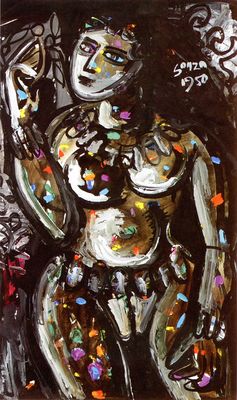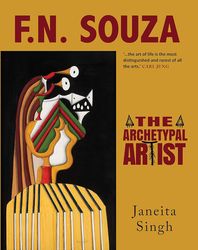Janeita Singh's The Archetypal Artist opens with a subtle warning, urging the reader to be prepared for a high-voltage zone. It is the unconventional realm of renowned modernist painter―Francis Newton Souza. We stumble into an alternative universe of liberated women and men thriving in a world stripped of its hypocrisy and norms.
Armed with over 130 images of Souza's artworks, Singh's 21 essays unravel the mystique that Souza was. Singh delves deep into Souza's works, which she believes are mined from his soul. Singh analyses how they reflect the human psyche. As we delve around Singh's feminist reading of Souza, it is imperative to understand how mammoth a figure he remains in the art world.
In 1947, just months after a new India was born, a radical change shook the country's art scene. Six diverse artists from different parts of the country formed a collective―the Bombay Progressive Artists’ Group―seeking to reject the nationalist Bengal School of Art (a movement dominated by Indian imagery). They embraced the west and its techniques, but with influences from traditional Indian art. So they were immediately ostracised. But the progressive movement thrived, redefining Indian modern art. Souza's role in ushering in the Indian avant-garde with his visceral and provocative works was monumental. But Souza’s works, which were dominated by Catholic elements (from his Goan upbringing), nudity, and grotesque figurines, also made him an outcast in India. So much so that, Souza left India for Britain in 1949, after he faced obscenity charges for a seven-foot-tall nude self-portrait.
Souza, whom M.F. Husain called his mentor, remained shrouded in relative obscurity in his birth country for a long time. However, as the art sphere began to view modernism beyond the borders of the west, there was a renewed interest in modernist painters like Souza. In March this year, on his 100th birth anniversary, Souza's iconic work―The Lovers' (1960)―was sold for a record-breaking Rs40 crore at Christie's New York.
Singh's research offers an assessment of Souza's work, predominantly his representation of women and their sexuality. An academician-turned-art-critic, Singh preps the reader for the ride. “The book will help the readers embark on a quest to understand the human body and sexuality, and the power vested therein―a subject of stigma for centuries due to incessant friction with our social and spiritual values,” she says.
Singh perfectly anchors her analysis on Souza's standing as a feminist icon who, in liberating women sexually, liberated himself. His art rallied against the collective conscience, mocking the morals of civilised society. Souza did it in many ways―by blurring the lines between the virtuous and sinful ones, and by exploring the human psyche and the beast within us.
Souza took inspiration from Indian classical temple art to bring back the grotesque, a form of primitive art, to modernism. His work―US Senator on Time Cover (1962)―invokes horror while mocking authority, while Nude Queen (1962) illustrates an unconventional nude woman. His Prakriti Yoni (1984) leaves a similar impression.
The brilliance of Singh's essays is that they let us slowly soak in the multiple layers of Souza's art. And the result: we confront everything we sought to repress for the fear of social shame and stigma.
F.N. SOUZA: THE ARCHETYPAL ARTIST
By Janeita Singh
Published by Niyogi Books
Price: Rs4,500; pages: 320





